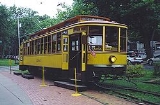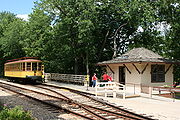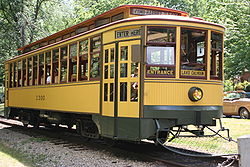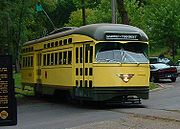
Como-Harriet Streetcar Line
Encyclopedia
The Como-Harriet Streetcar Line (CHSL) is a heritage streetcar
line in Minneapolis, Minnesota
which follows original streetcar right-of-way between Lake Harriet and Lake Calhoun and is operated by the Minnesota Streetcar Museum
. The heritage line was originally developed in the 1970s by the Minnesota Transportation Museum
which spun off streetcar operations in the winter of 2004-2005.
ceased streetcar operations in 1954 they donated two of their old wooden streetcars to railfan
groups. One of the groups receiving a streetcar (TCRT No. 1300) was the Minnesota Railfans Association, which organized railfan trips from the 1940s-1960s. TCRT No. 1300 was stored outside until it was acquired by the Minnesota Transportation Museum in 1962 and restoration began. By 1963 the car had been restored to operational status. It originally made only some short trips along track at a roundhouse in St. Paul owned by the Minnesota Transfer Railway
. Because there were no overhead electric lines at this location the streetcar had to be powered by an electric generator towed behind the car. Despite these shortcomings the car was extremely popular with the public.
Since public interest was so high, the museum examined options for regular operation of No. 1300. The City of Minneapolis and the Minneapolis Park and Recreation Board had acquired the original streetcar right-of-way between Lake Harriet and Lakewood Cemetery near Lake Calhoun and in 1970, the Minnesota Transportation Museum leased the land.
On August 28, 1971 after track had been laid and a small carbarn constructed under the Queen Avenue Bridge
, which passed over the original right-of-way, public operations began. Because no overhead wires had been strung to provide electricity the trailer mounted electrical generator continued to be used until the overhead electrical system was completed in 1973.
Continued popularity of the heritage line allowed the museum to expand from about one city block of track in 1971 to more than one mile of track in operation today. By 2005 continual use had taken its toll on the track and a rebuilding project funded by a federal TEA-21 grant took place. Over time more streetcars were acquired and restored by the museum and today three different streetcars which can be seen in operation on the Como-Harriet line, although only one or two are run at any given time. The line itself is listed on the National Register of Historic Places.
 The original streetcar station at Linden Hills was built one block north of the intersection of Queen Ave and 42nd Street in 1900. As time progressed TCRT desired to make Lake Harriet an entertainment destination in an effort to increase recreational ridership. At this time they built the original Lake Harriet Bandshell and began sponsoring concerts at the lake. Because of the larger crowds being drawn to the lake there was a need for a larger station and in 1914 a larger chalet-style structure replaced the original building, which was moved closer to the lake and used for other purposes. The chalet station existed until 1954 when streetcar operations ceased at which time it was torn down.
The original streetcar station at Linden Hills was built one block north of the intersection of Queen Ave and 42nd Street in 1900. As time progressed TCRT desired to make Lake Harriet an entertainment destination in an effort to increase recreational ridership. At this time they built the original Lake Harriet Bandshell and began sponsoring concerts at the lake. Because of the larger crowds being drawn to the lake there was a need for a larger station and in 1914 a larger chalet-style structure replaced the original building, which was moved closer to the lake and used for other purposes. The chalet station existed until 1954 when streetcar operations ceased at which time it was torn down.
By the time the Minnesota Transportation Museum began construction of the heritage line all that remained was the concrete slab used as a platform for loading and unloading passengers. In 1990, the Museum built a recreation based on the smaller original Linden Hills Station. Today the station is used for purchasing tokens to ride the streetcars, souvenirs, and contains displays of Twin City Lines History.
 The first streetcar operated by the Museum was Twin City Rapid Transit Company streetcar No. 1300. The car, which now appears much like it did in the 1930s-1950s era, was built by Twin City Rapid Transit as a fast interurban streetcar in 1908, with a top speed of about 35 miles per hour (105 km/h). When in operation for Twin City Lines TCRT No. 1300 was based at the East Minneapolis Station (carbarn) and often operated on the original Como-Harriet route.
The first streetcar operated by the Museum was Twin City Rapid Transit Company streetcar No. 1300. The car, which now appears much like it did in the 1930s-1950s era, was built by Twin City Rapid Transit as a fast interurban streetcar in 1908, with a top speed of about 35 miles per hour (105 km/h). When in operation for Twin City Lines TCRT No. 1300 was based at the East Minneapolis Station (carbarn) and often operated on the original Como-Harriet route.
Since 2003, TCRT No. 1300 has undergone extensive overhauling of its internal wiring, exterior, and internal wood and steel support structure as it hadn't had a major overhaul/rebuilding since the late 1940s. This was done for preparation of its 100th birthday in the year 2008.
streetcar system was put in service on CHSL after nine years of restoration work in 1982. It had originally been built in 1915 by TCRT as No. 1791, but was sold to Duluth the next year. It operated there until Duluth's streetcar system was abandoned in 1939.
The car was sold and converted into a summer cabin in Solon Springs, Wisconsin, a fate that was not unusual for old wooden streetcars that managed to escape being burned up as streetcar lines abandoned. The interior had been removed, so important pieces like the railroad trucks
, the electric wiring, and other parts had to be scavenged from other old streetcars or rebuilt from scratch.
 TCRT built most of its own streetcars in its own shops (31st Street in Minneapolis from 1898 through 1907 and Snelling in Saint Paul from 1907 through the late 1920s) throughout the company's history. But a number of faster streamlined
TCRT built most of its own streetcars in its own shops (31st Street in Minneapolis from 1898 through 1907 and Snelling in Saint Paul from 1907 through the late 1920s) throughout the company's history. But a number of faster streamlined
vehicles were purchased in the late 1940s to better compete with the popularity of the automobile
. TCRT No. 322 was a Presidents' Conference Committee, or PCC streetcar
built by the St. Louis Car Company
in 1946. It served in the Twin Cities until it was sold in 1953 to Public Service Coordinated Transit in New Jersey, one of thirty streetcars purchased for use in the Newark City Subway. It was later sold to the Shaker Heights Rapid Transit in Cleveland, Ohio
in 1978 to replace two wreck-damaged cars. After the car was acquired by the Museum in 1990, it underwent ten years of restoration, entering service in 2000.
Heritage streetcar
Heritage streetcars or heritage trams are a development of the heritage railways that are becoming popular across the world. As with modern streetcar systems, the vehicles are referred to as trams or tramcars in the United Kingdom, Australasia and certain other places , but as streetcars or...
line in Minneapolis, Minnesota
Minneapolis, Minnesota
Minneapolis , nicknamed "City of Lakes" and the "Mill City," is the county seat of Hennepin County, the largest city in the U.S. state of Minnesota, and the 48th largest in the United States...
which follows original streetcar right-of-way between Lake Harriet and Lake Calhoun and is operated by the Minnesota Streetcar Museum
Minnesota Streetcar Museum
The Minnesota Streetcar Museum is a transport museum that operates two heritage streetcar lines in Minneapolis, Minnesota and the western suburb of Excelsior....
. The heritage line was originally developed in the 1970s by the Minnesota Transportation Museum
Minnesota Transportation Museum
The Minnesota Transportation Museum is a transport museum in Saint Paul, Minnesota.The MTM operates several heritage transportation sites in Minnesota and one in Wisconsin...
which spun off streetcar operations in the winter of 2004-2005.
Heritage line history
When Twin City Rapid TransitTwin City Rapid Transit
The Twin City Rapid Transit Company , also known as Twin City Lines , was a transportation company that operated streetcars, and buses in the Minneapolis-St. Paul metropolitan area in the U.S. state of Minnesota...
ceased streetcar operations in 1954 they donated two of their old wooden streetcars to railfan
Railfan
A railfan or rail buff , railway enthusiast or railway buff , or trainspotter , is a person interested in a recreational capacity in rail transport...
groups. One of the groups receiving a streetcar (TCRT No. 1300) was the Minnesota Railfans Association, which organized railfan trips from the 1940s-1960s. TCRT No. 1300 was stored outside until it was acquired by the Minnesota Transportation Museum in 1962 and restoration began. By 1963 the car had been restored to operational status. It originally made only some short trips along track at a roundhouse in St. Paul owned by the Minnesota Transfer Railway
Minnesota Transfer Railway
The Minnesota Transfer Railway was a short line railroad in the United States.It was owned by nine major railroads serving the Twin Cities: the Chicago, Burlington and Quincy Railroad, the Chicago Great Western Railway, the Chicago, Milwaukee, St. Paul and Pacific Railroad, the Chicago, Rock...
. Because there were no overhead electric lines at this location the streetcar had to be powered by an electric generator towed behind the car. Despite these shortcomings the car was extremely popular with the public.
Since public interest was so high, the museum examined options for regular operation of No. 1300. The City of Minneapolis and the Minneapolis Park and Recreation Board had acquired the original streetcar right-of-way between Lake Harriet and Lakewood Cemetery near Lake Calhoun and in 1970, the Minnesota Transportation Museum leased the land.
On August 28, 1971 after track had been laid and a small carbarn constructed under the Queen Avenue Bridge
Queen Avenue Bridge
The Queen Avenue Bridge is a reinforced concrete single-span barrel arch bridge in Minneapolis, Minnesota that spans the tracks used by the Minnesota Streetcar Museum. The bridge was built in 1905 and is listed on the National Register of Historic Places....
, which passed over the original right-of-way, public operations began. Because no overhead wires had been strung to provide electricity the trailer mounted electrical generator continued to be used until the overhead electrical system was completed in 1973.
Continued popularity of the heritage line allowed the museum to expand from about one city block of track in 1971 to more than one mile of track in operation today. By 2005 continual use had taken its toll on the track and a rebuilding project funded by a federal TEA-21 grant took place. Over time more streetcars were acquired and restored by the museum and today three different streetcars which can be seen in operation on the Como-Harriet line, although only one or two are run at any given time. The line itself is listed on the National Register of Historic Places.
Linden Hills Station

By the time the Minnesota Transportation Museum began construction of the heritage line all that remained was the concrete slab used as a platform for loading and unloading passengers. In 1990, the Museum built a recreation based on the smaller original Linden Hills Station. Today the station is used for purchasing tokens to ride the streetcars, souvenirs, and contains displays of Twin City Lines History.
TCRT No. 1300

Since 2003, TCRT No. 1300 has undergone extensive overhauling of its internal wiring, exterior, and internal wood and steel support structure as it hadn't had a major overhaul/rebuilding since the late 1940s. This was done for preparation of its 100th birthday in the year 2008.
DSR No. 265
Other streetcars were also added in later years. A streetcar once operated on the TCRT-operated DuluthDuluth, Minnesota
Duluth is a port city in the U.S. state of Minnesota and is the county seat of Saint Louis County. The fourth largest city in Minnesota, Duluth had a total population of 86,265 in the 2010 census. Duluth is also the second largest city that is located on Lake Superior after Thunder Bay, Ontario,...
streetcar system was put in service on CHSL after nine years of restoration work in 1982. It had originally been built in 1915 by TCRT as No. 1791, but was sold to Duluth the next year. It operated there until Duluth's streetcar system was abandoned in 1939.
The car was sold and converted into a summer cabin in Solon Springs, Wisconsin, a fate that was not unusual for old wooden streetcars that managed to escape being burned up as streetcar lines abandoned. The interior had been removed, so important pieces like the railroad trucks
Bogie
A bogie is a wheeled wagon or trolley. In mechanics terms, a bogie is a chassis or framework carrying wheels, attached to a vehicle. It can be fixed in place, as on a cargo truck, mounted on a swivel, as on a railway carriage/car or locomotive, or sprung as in the suspension of a caterpillar...
, the electric wiring, and other parts had to be scavenged from other old streetcars or rebuilt from scratch.
TCRT PCC No. 322

Streamliner
A streamliner is a vehicle incorporating streamlining in a shape providing reduced air resistance. The term is applied to high-speed railway trainsets of the 1930s to 1950s, and to their successor "bullet trains". Less commonly, the term is applied to fully faired recumbent bicycles...
vehicles were purchased in the late 1940s to better compete with the popularity of the automobile
Automobile
An automobile, autocar, motor car or car is a wheeled motor vehicle used for transporting passengers, which also carries its own engine or motor...
. TCRT No. 322 was a Presidents' Conference Committee, or PCC streetcar
PCC streetcar
The PCC streetcar design was first built in the United States in the 1930s. The design proved successful in its native country, and after World War II was licensed for use elsewhere in the world...
built by the St. Louis Car Company
St. Louis Car Company
The St. Louis Car Company was a major United States manufacturer of railroad passenger cars, streetcars, trolleybuses and locomotives that existed from 1887–1973, based in St. Louis, Missouri.-History:...
in 1946. It served in the Twin Cities until it was sold in 1953 to Public Service Coordinated Transit in New Jersey, one of thirty streetcars purchased for use in the Newark City Subway. It was later sold to the Shaker Heights Rapid Transit in Cleveland, Ohio
Ohio
Ohio is a Midwestern state in the United States. The 34th largest state by area in the U.S.,it is the 7th‑most populous with over 11.5 million residents, containing several major American cities and seven metropolitan areas with populations of 500,000 or more.The state's capital is Columbus...
in 1978 to replace two wreck-damaged cars. After the car was acquired by the Museum in 1990, it underwent ten years of restoration, entering service in 2000.
See also
- Twin City Rapid TransitTwin City Rapid TransitThe Twin City Rapid Transit Company , also known as Twin City Lines , was a transportation company that operated streetcars, and buses in the Minneapolis-St. Paul metropolitan area in the U.S. state of Minnesota...
- Minnesota Streetcar MuseumMinnesota Streetcar MuseumThe Minnesota Streetcar Museum is a transport museum that operates two heritage streetcar lines in Minneapolis, Minnesota and the western suburb of Excelsior....

